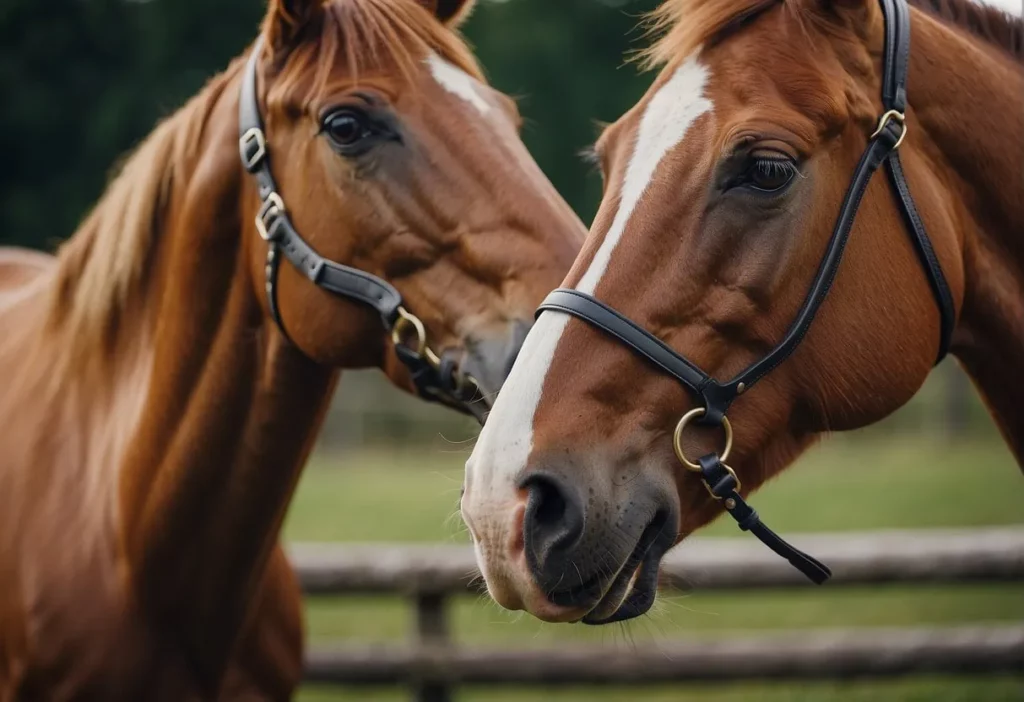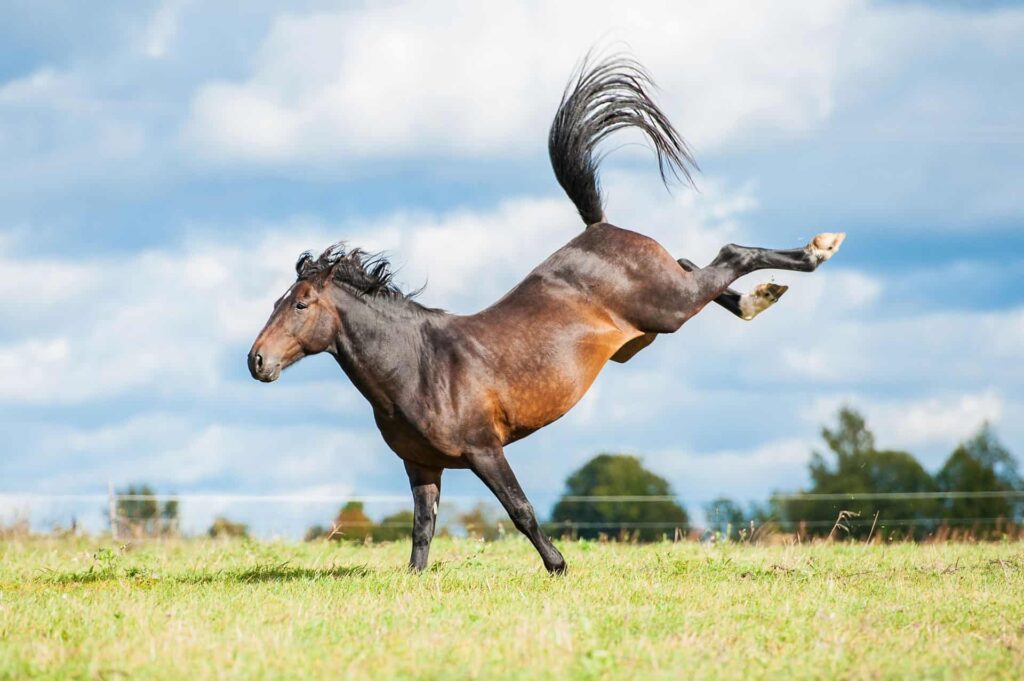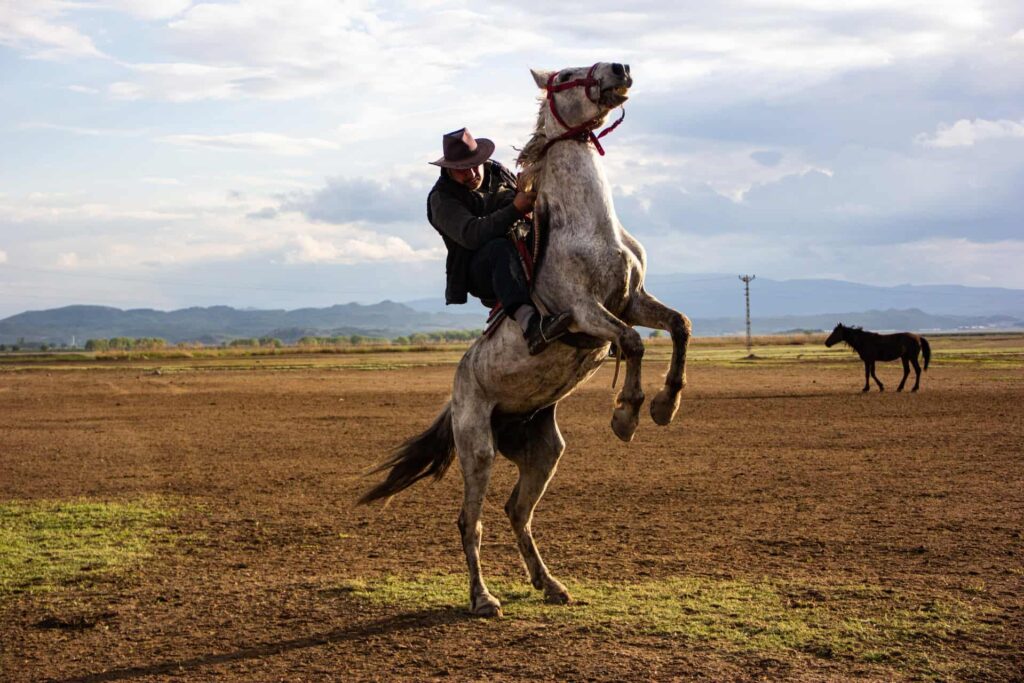Horse biting can be both a dangerous and frustrating behavior for horse owners and handlers to address. Understanding the reasons behind why a horse may bite is essential to effectively correct the behavior.
Often, biting is a horse’s way of communicating discomfort, fear, or confusion, and can stem from a variety of factors. These factors include past traumas, improper handling, or even discomfort due to dental issues. Addressing biting behavior requires a multifaceted approach that includes recognizing signs of distress, implementing training strategies to reinforce positive behavior, and ensuring safe handling practices.
It’s important to handle this issue with patience and consistency, taking care to avoid any actions that may exacerbate the problem In some cases, professional intervention may be necessary to address underlying causes or to establish safer handling protocols.
Key Takeaways
- Recognize the motivations behind horse biting to address it effectively.
- Use consistent training strategies to reinforce positive behavior.
- Ensure safe handling and consider professional guidance for persistent issues.
Understanding Horse Behavior
In addressing why horses bite, it is essential to comprehend their behavior patterns and triggers for aggression. These triggers are often grounded in their instincts and social structures.
Recognizing Aggression and Biting Behavior
Horses may exhibit aggression for various reasons ranging from fear to establishing dominance. Biting is a clear sign of such behavior.
It is imperative to observe a horse’s body language—ears pinned back, showing teeth, or snapping are indicators that a bite may be imminent.
The Role of Equine Behavior in Biting
Equine behavior is a complex mix of innate responses and learned experiences. Horses can bite as a defense mechanism or out of annoyance. Understanding the nuances of equine psychology helps in identifying potential biting situations before they escalate.
Distinguishing Between Different Types of Horse Bites
Not all bites are equal; they can be playful nips, assertive bites, or aggressive attacks.
Playful bites are usually gentler and a part of social interaction. Meanwhile, assertive bites may occur during feeding when a horse is asserting dominance. Identifying the type of bite can guide appropriate training and intervention measures.
Common Causes of Biting
Biting behavior in horses can stem from various causes, ranging from developmental stages in young horses to discomfort and behavioral issues. Understanding these triggers is essential for addressing and mitigating biting habits effectively.
Dealing With Teething in Young Horses
Young horses, like many mammals, may experience discomfort during their teething phase.
Teething generally occurs when a horse is between several months to two years old and can lead to nipping as they try to alleviate gum irritation.
Providing appropriate teething toys can redirect this behavior and prevent a young horse from developing harmful biting habits.
Identifying Physical Discomfort
Biting can be a sign of physical discomfort in horses.
A poorly fitting or uncomfortable saddle, or a tight girth, can cause pain and lead to nipping as a response.
Regularly checking and adjusting tack to ensure a proper fit, as well as observing for any signs of pain during grooming or tacking, can help identify and correct sources of discomfort.
Managing Pent-Up Energy and Cribbing
Horses that have excessive pent-up energy may resort to biting as an outlet. Ensuring adequate exercise and stimulation can mitigate this behavior.
Additionally, some horses develop a habit called cribbing, where they bite and latch onto surfaces, which can be exacerbated by stress or lack of stimulation.
Implementing proper feeding management and an environment that allows for free movement and grazing can reduce stress and deter cribbing behaviors.
Effective Training Strategies
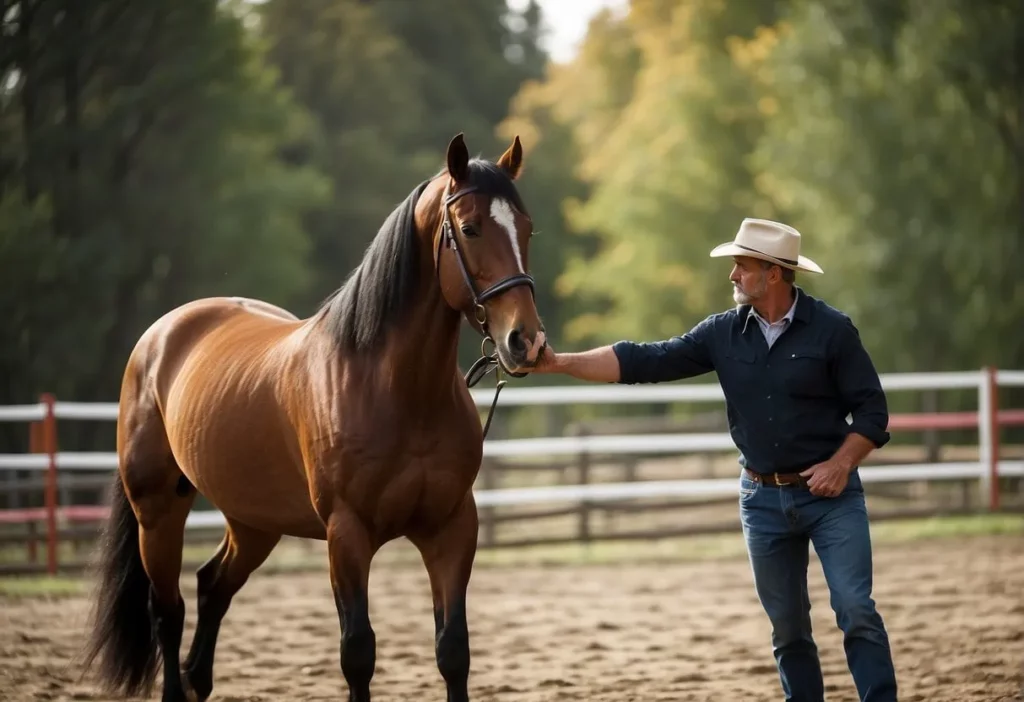
To effectively curb biting behavior in horses, trainers should adhere to structured approaches that enhance the horse’s learning experience. The following subsections explore the most reliable methods.
Implementing Consistent Training Methods
Consistent training is essential for clarity and results.
Trainers should establish a routine that horses can anticipate, strengthening the association between specific behaviors and outcomes.
Consistency in commands, tone of voice, and handling helps horses understand and follow expectations, minimizing confusion that could lead to biting.
Positive Reinforcement Techniques
Positive reinforcement rewards horses for desired behavior, such as remaining calm and not biting.
Rewarding with treats, affection, or a relaxing grooming session can reinforce the behavior trainers wish to see.
This technique, acknowledged in studies on horse training and welfare, promotes a cooperative relationship between horse and trainer.
Clicker Training Basics
Clicker training incorporates a sound-making device to mark desired behavior, followed immediately by a reward.
This clear form of communication helps horses associate the click with positive outcomes, such as treats, creating a powerful incentive for them not to bite.
It’s a training technique grounded in equine learning theory and can be quite effective when used correctly.
Safe Handling and Interaction
Safe handling and interaction with horses are paramount to prevent biting and ensure both human safety and horse welfare. Specific techniques and an understanding of horse behavior contribute to creating a secure environment.
Establishing Mutual Respect
One must consistently demonstrate leadership through confident, calm, and assertive handling techniques.
This establishes a hierarchy where the horse sees the handler as a leader. Clear boundaries and consistent responses to biting behavior discourage it from becoming a habit.
For example, if a horse attempts to bite, one should respond promptly and appropriately by firmly saying “no” and moving the horse’s head away.
Proper Hand-Feeding Practices
Hand-feeding can encourage biting if not done correctly.
It is important to offer treats with a flat palm and fingers close together, ensuring the horse takes the food gently.
This technique minimizes the risk of accidental nips and discourages snatchy behavior.
Additionally, treats should only be given as rewards for specific positive behaviors to reinforce good manners.
Understanding Horse Body Language
Interpreting the subtle cues in horse body language prevents misunderstandings that could lead to biting.
Recognizing signs of discomfort, fear, or aggression allows the handler to adjust their approach accordingly.
For instance, ears pinned back, swinging heads or tense posture are indicators that a horse may be preparing to bite. Observing these signs enables handlers to take preventative action to avert a bite.
Professional Intervention
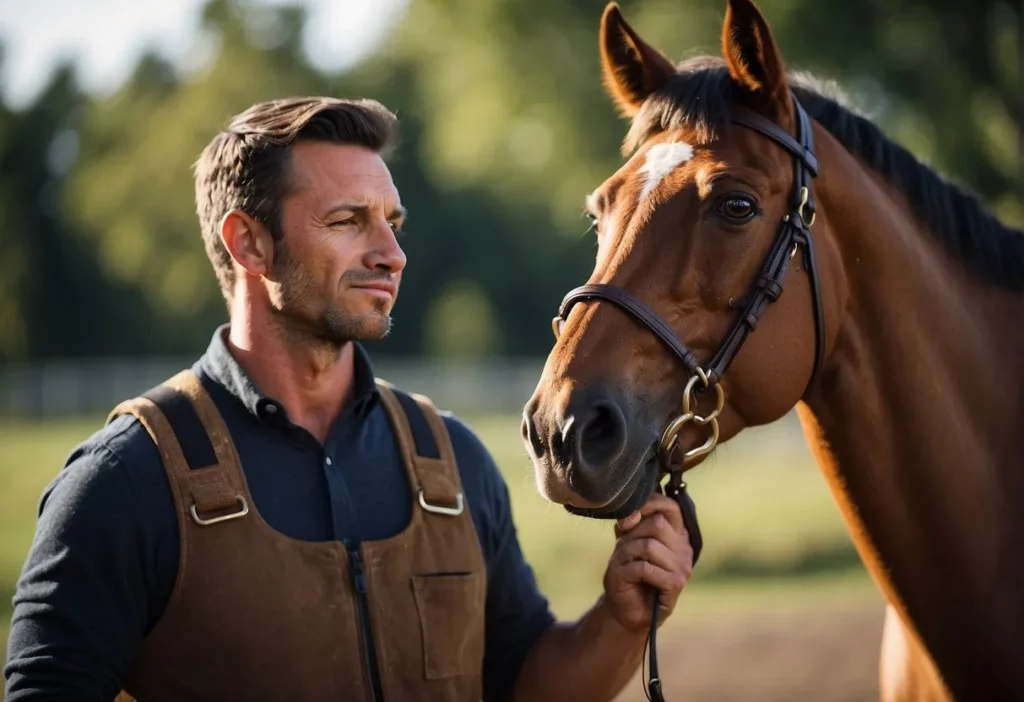
In cases where a horse persistently bites, it’s crucial to involve professionals who specialize in equine behavior and veterinary care. Their expertise is key to addressing any underlying issues contributing to the behavior.
When to Consult an Equine Behaviorist
Equine behaviorists are invaluable when standard corrective methods fail. One should consult an equine behaviorist if:
- The horse bites aggressively, without clear triggers.
- Biting persists despite consistent training efforts.
- Behavioral changes occur suddenly, without an apparent cause.
Behaviorists assess the horse’s environment, past trauma, and current handling. They develop tailored programs that may involve desensitization, positive reinforcement, and structured training.
The Role of a Veterinarian in Treating Biting
Veterinarians play a critical role in ruling out medical causes for biting. Instances that necessitate a veterinarian include:
- Biting is associated with pain during grooming or saddling.
- Changes in eating habits, could indicate dental issues.
The veterinarian conducts a thorough examination, possibly identifying conditions such as ulcers or dental problems that may cause discomfort and lead to biting as a defense mechanism.
If such issues are found, treatment plans including pain management or surgical interventions may be suggested. Collaboration with a professional trainer may also be recommended to re-establish safe handling practices post-treatment.
Preventative Measures
Addressing equine behavioral issues requires not only understanding the causes but also implementing effective preventative strategies. This section explores the key approaches to curbing unwanted behaviors such as biting in horses through environmental enrichment and the role of allogrooming.
Environmental Enrichment Options
Environmental enrichment is crucial in reducing stress and boredom, which can lead to biting and other stereotypic behaviors.
Here are specific strategies to enhance a horse’s living conditions:
- Variety in Diet: Presenting different forages and placing them in multiple locations encourages foraging behavior and increases feeding time. This mimics the natural grazing patterns and provides mental stimulation.
- Toys and Objects: Introduce safe, durable toys that can be manipulated or chewed. This redirection gives horses an appropriate outlet for their chewing instincts.
- Regular Exercise: Ensure horses have ample opportunity for physical exercise. This can include turnout in a safe, spacious paddock or structured exercise programs like lunging or riding.
These methods aim to simulate a more natural environment for the horse, keeping it both physically active and mentally engaged.
The strategy of providing environmental enrichment has been shown to help in preventing undesirable behaviors such as crib-biting, which can be associated with biting tendencies.
The Importance of Allogrooming
Allogrooming, the social behavior where horses groom each other, not only reinforces social bonds but also serves as a natural behavior that can prevent stress-related issues such as biting.
Implementing ways to facilitate allogrooming can contribute to a horse’s well-being:
- Social Interaction: Horses are social animals and thrive on interaction with conspecifics. Allow for safe, controlled contact with other horses to encourage natural social behaviors like allogrooming.
- Group Housing: Whenever possible, keeping horses in small groups rather than in isolation can promote regular allogrooming sessions. Appropriate pairings are important to ensure harmonious relationships and reduce the risk of aggression.
Strategic social groupings and the provision of opportunities for allogrooming can help in curbing behavioral problems.
It is understood that horses engaged in allogrooming exhibit reduced levels of stress, which can indirectly reduce occurrences of biting.
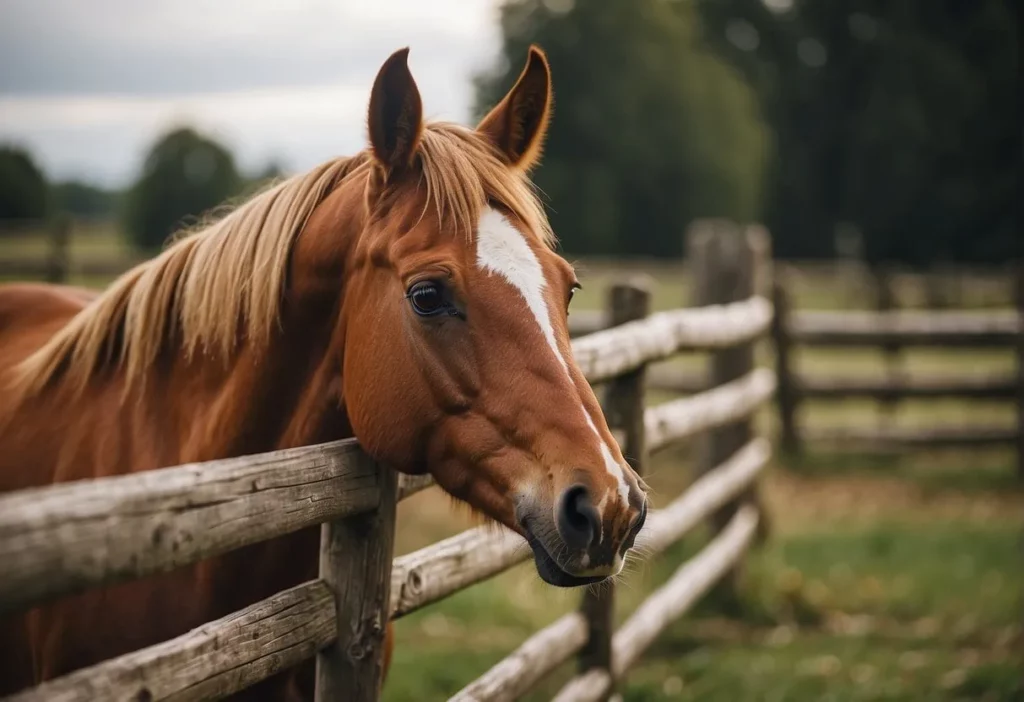
Additional Resources
The following resources can provide in-depth information and practical techniques to help individuals address and prevent biting behavior in horses.
Recommended Literature and Books
One can find valuable insights into equine behavior and effective training methods in the literature.
For instance, a book like “Managing horses on small properties” offers guidance on various aspects of equine care, including strategies to deter undesirable behaviors such as biting.
Exploring scientific research, such as the study on “Physiological and behavioral consequences associated with short-term prevention of crib-biting in horses,” can offer a deeper understanding of underlying causes and solutions for biting issues.
Learning from Experts like Monty Roberts
Monty Roberts, known as the “Man Who Listens to Horses,” has pioneered non-violent methods of horse training that can help in addressing biting behaviors.
Studying Roberts’ techniques through his books, and videos, and attending live demonstrations or clinics can provide one with a comprehensive approach to fostering trust and respect between horses and humans, thereby reducing the tendency for horses to bite.
His book, “The Man Who Listens to Horses,” delves into his philosophy and methods, which emphasize communication and cooperation over coercion.
Adoption and Horse Shopping
When considering adding a horse to your life through adoption or shopping, it is imperative to choose wisely and prepare for the responsibilities that come with equine companionship.
Choosing the Right Horse
Selecting the right horse is crucial, whether you’re adopting from a rescue or shopping at a sale.
Potential owners should focus on a horse’s temperament instead of just its aesthetics.
A docile horse with a calm demeanor is less likely to develop biting habits compared to one that is high-strung or nervous.
One should assess the horse’s past behavior and training to ensure that it aligns with their skill level and riding goals.
Key factors include:
- Health: The horse should be in good health, with no signs of illness or troubling behavior like excessive wood chewing or stable biting.
- History: An understanding of the horse’s background, including any previous training, can help avoid issues such as biting.
Considerations Before Adoption
Before moving forward with adopting a horse, there are several considerations that must be addressed.
- Verify the credibility of the rescue organization or seller to ensure that they are reputable and that the horses have been well-cared for.
- Inquire about the horse’s history and look for any signs of biting injuries or other problematic behaviors.
- Conduct a pre-adoption visit to interact with the horse in various scenarios, observing its reactions and behavior.
- Engage a veterinarian to perform a pre-purchase exam to assess the horse’s health status comprehensively.
Pre-adoption checklist:
- [] Confirm the liability and return policy of the organization or seller.
- [] Interact with the horse multiple times at different times of the day.
- [] Observation of the horse’s behavior in social settings with humans and other horses.
Understanding Stallions and Colts
Stallions and colts require specific handling and training techniques due to their instincts and behavior patterns.
Stallions often display dominance, which must be managed carefully, while younger colts need foundational training to prevent biting and other undesirable behaviors.
Handling Techniques for Stallions
When it comes to stallions, clear boundaries and consistent routines are essential.
Handlers should establish themselves as the leader through firm, calm, and deliberate actions, which can mitigate dominant behaviors:
- Approach calmly: Always approach a stallion in a non-threatening manner to avoid triggering his instincts to establish dominance.
- Use a firm touch: Be definite in your handling, using consistent pressure when leading or correcting to communicate your expectations clearly.
- Provide sufficient space: Recognize a stallion’s need for personal space and avoid crowding him, which could lead to defensive biting.
Training Basics for Colts
Colts benefit from early and consistent training to prevent the development of biting as a behavioral problem.
Patience and positive reinforcement play key roles in their education:
- Start young: Introduce colts to handling as early as possible to acclimate them to human interaction.
- Positive reinforcement: Use treats or praise to reward desired behavior, reinforcing the actions you want without aggression.
- Short sessions: Keep training sessions brief but regular to maintain their attention and prevent frustration.
Last Updated on March 11, 2024 by Nate Dewsbury
